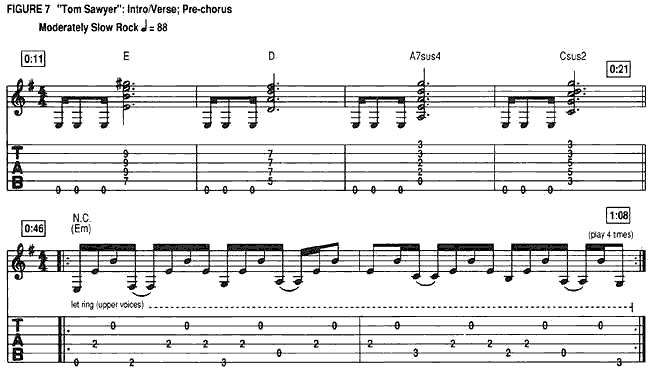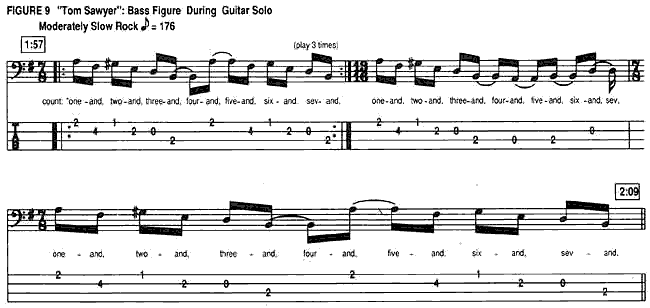
Rush's Greatest Riffs
By Troy Stetina
Guitar World, February - 1994
Updated and revised (c) 2020 Troy Stetina
More than 20 years and 19 albums into their career, Rush continue to defy easy classification. On their latest album, Counterparts, Alex Lifeson, Geddy Lee and Neil Peart have come full circle, returning to the sort of heavy, guitar-oriented riffs that marked their Seventies sound. Let's take a look at some highlights of the band's stylistic development.
Looking back to their self-titled 1974 debut, we have the unforgettable riff that powers "Working Man," a seven-minute jam that showcased the band's live prowess, which is emblematic of their early rock/metal approach. Figure 1 shows the song's main riff as it is played during the intro and verse sections. Notice how the riff's plodding quality so effectively mirrors the lyrics. Texturally, it strikes an inventive mix between chords and single notes: the E5 chord punches the beginning of each measure, firmly anchoring the tonal center, followed by cutting single-note end tags. As these endings repeat in a cyclical pattern, they develop into a question/answer (or antecedent/consequent) structure. This two-part structure is known as binary form. Harmonically, the first measure introduces the notes E, A, B, D, which suggest E minor-pentatonic (E, G, A, B, D). However, as no major or minor third is delineated -- no G or G# -- there is no clear-cut rnajor or minor tonality established. The result is an intentional harmonic ambiguity.

The second measure utilizes the notes E, B, C and D, suggesting the darker flavor of E natural minor, or Aeolian (E-F#-G-A-B-C-D), but again, no third is explicitly stated. This type of harmonic ambiguity is common to the rock vocabulary and can be found throughout the music of Rush's contemporaries, including Aerosmith, AC/DC and ZZ Top, as well as earlier English rock legends like the Stones, The Who, The Kinks and Led Zeppelin.
Also evident in "Working Man" is Rush's early attention to song dynamics. At key points during the verses, the riff's single notes are expanded into full-blown chords, as shown in Figure 2. The heretofore harmonically ambiguous E5 chord becomes a full E major in the second measure, now explicitly contradicting the implied minor modality of the single-note riff and effectively blurring the distinction between major and minor. This blending of major/minor tonality is a classic heavy rock characteristic and appears extensively in the Rush catalogue, from such early songs "Finding My Way" and "In The Mood" (Rush, 1974) to later instances such as "Tom Sawyer" (Moving Pictures, 1981).
As Rush progressed, their compositional sophistication became increasingly apparent, as evidenced by their development of musical themes and ideas. Figures 3 and Figure 4 illustrate a type of rhythmic development in the concept piece "2112." Figure 3 is an excerpt from the first section of the piece, entitled "Overture," and begins with a chord sequence played in stop-time -- that is, without a clearly defined underlying beat. Later, the progression is restated with a different rhythmic treatment, appearing as the verse riff in the piece's next section, entitled "Temples Of Syrinx" and shown in Figure 4. In fact, many of the musical ideas first presented in "Overture" are later restated in "Temples." This foreshadowing technique creates a tightly interwoven musical landscape, where a strong thread of continuity ties sections together as the piece unfolds. Other great examples of rhythmic development in Rush's music can be found in "La Villa Stangiato" (Hemispheres, 1978) and in the variations of the central riff figure in "Limelight" (Moving Pictures, 1981).

To counterbalance the band's hard-driving, often pentatonically-based riffs with a broader textural range, Lifeson began to incorporate arpeggiated figures early on. The thematic figure at the heart of "Fly by Night" is of particular interest, as it contains one of Lifeson's arpeggiation techniques in seed form (Figure 5, below). The ringing notes on the top three strings function as common tones above a moving, arpeggiated bass-line melody. This technique of sounding open-string common tones in the upper voices while a bass line moves underneath is a Rush trademark. Other examples of this technique can be found, for example, in the verse figure of "The Spirit of Radio" (Permanent Waves, 1980) beginning at 0:35, and in the chorus of "Limelight" at 1:01.

Figure 6 is the central theme of "Closer To The Heart" from A Farewell to Kings, 1977. This marks another step in the evolution of Alex's accompaniment style. An open string appears within an arpeggiated sequence, but this time it adds a color tone into the chord—an open B string is played against an A chord, producing the hanging, suspended sound of Aadd9 (or Aadd2). The chord remains static throughout the figure. Measures 2 and 3 show a union of both of these arpeggiation techniques: The top voice sustains the ringing open high E string, which acts as both common tone and a color tone within each chord, while the chords/bass move underneath. Over G major, the E note creates G6 (G-B-D-E); over D/F# it creates Dadd9/F# (F#-A-D-E), and over F major it creates Fmaj7 (F-A-C-E).

Figure 7, from "Tom Sawyer" (Moving Pictures, 1981), demonstrates a third phase in Lifeson's distinct accompaniment approach. Here simple power chords that had been a staple of Rush's early sound have given way to more complex, suspended-type chords. With its slightly processed chorus/delay, the guitar in "Tom Sawyer" conveys a richer, deeper texture and a somewhat distant, dreamy sound. Measures 5 and 6, from the song's pre-chorus, demonstrate another instance of holding common tones over a moving bassline. Similar to the idea first seen in "Fly by Night" (in Part 1), the technique employed here dominates an entire section of the song with its fluid feel and dark, minor modality.

Figure 8 below depicts several of Lifeson's more commonly used open-string add and sus chords. These chords color a number of Rush songs, including "Jacob's Ladder" (Permanent Waves, 1980) and "Dreamline" (Roll The Bones, 1991). Sometimes they appear in arpeggiated form while at other times they are simply strummed as full chords.

Alex has also developed a number of other techniques to create a wider spectrum of rhythmic texture. Generally, these consist of using short, repeating figures. At times he can be seen to create a hypnotic effect by playing repeating arpeggio patterns on a clean, chorused electric guitar, thereby building the foundation upon which everything rests. This type of approach can be heard at 0:27 of "La Villa Strangiato." A variation on this concept appears in the intro and chorus of "The Spirit of Radio" as the distinctive and repetitive guitar figure. Although not technically an arpeggio, the chords and bass nevertheless move underneath the guitar's repeated 16th-note pattern, creating a similar pedal tone feel.
Another fundamental element of Rush's style is undoubtedly their penchant for using odd time signatures and mixed meters. The bridge/solo section of "Tom Sawyer" is a classic example. First, a melody in 7/8 time is introduced by the synthesizer at 1:33. The guitar doubles it briefly, then the bass takes it over in a slightly altered variation and continues underneath the guitar solo. Figure 9, below, shows the bass line at the beginning of the solo section. After the upbeat kicks in the fourth bar, a half beat at the end of the measure is clipped off, resulting in the very unusual time signature of 13/16. Playing this correctly requires that you shift the upbeat into a downbeat at the start of the ensuing measure. (Otherwise, in the ensuing measure your downbeats will fall on the upbeats and vice versa.) The counting prompts under the staff show where the downbeat should fall.

"Freewill" (Permanent Waves, 1980) is another case in point, as it applies both unusual and mixed meters in the verse. Figure 10 (below) shows the underpinnings for the verse, which makes use of 6/4, 8/4, and 7/4 time all woven together in a seamless phrase.

The Dorian mode figures prominently in the guitar solo of "Freewill." Over a Dm-F progression, Alex blends a D minor-pentatonic approach (D, F, G, A, C) with the added 2nd and 6th degrees of the D Dorian mode (D, E. F, G, A, B, C). The first eight measures of the solo, shown below in Figure 11, are filled with characteristic "Lifeson-isms." After opening the solo with tortured series of pinch-harmonic string bends, Alex uses downstrokes to dig into the staggered, out-of-sync rhythmic figure — a group of four notes in the space of three. In measures 7 and 8 the dragging bends create an unusual, slightly seasick quality.

The keyboard/synthesizer sound took on an ever more significant role in the Eighties, on the albums Signals (1982), Grace Under Pressure (1984), Power Windows (1985) and Hold Your Fire (1987). More recently, however, Rush has signaled a change of direction that is bringing smiles to guitar players everywhere. Presto (1989) and Roll The Bones (1991) saw the trio moving back to a more guitar-dominated sound as in their early years, with standout songs like "Show Don't Tell." This trend continues with Counterparts, which combines their compositional finesse with grungey-sounding guitars and groove-oriented rhythms. A prime paradigm of this approach is the fat guitar/bass riff from the album's first single, "Stick It Out." (For a complete transcription, see Guitar World, Jan. '94.)
For more than two decades Rush has continued to expand the scope and language of rock to a higher level and a grander vision. Each musician shines within this supportive framework, yet together they create an effective synergy, where the whole is far more than the sum of its parts. Together, Lifeson, Lee and Peart consolidated the diversity and imagination of the sixties and defined a new direction in music.
*Update: After this article was first published in Guitar World in 1994, Rush have continued for an additional 25 years of writing, recording and touring, remaining an ever-evolving creative force. RIP Neil Peart - Jan 10, 2020.






